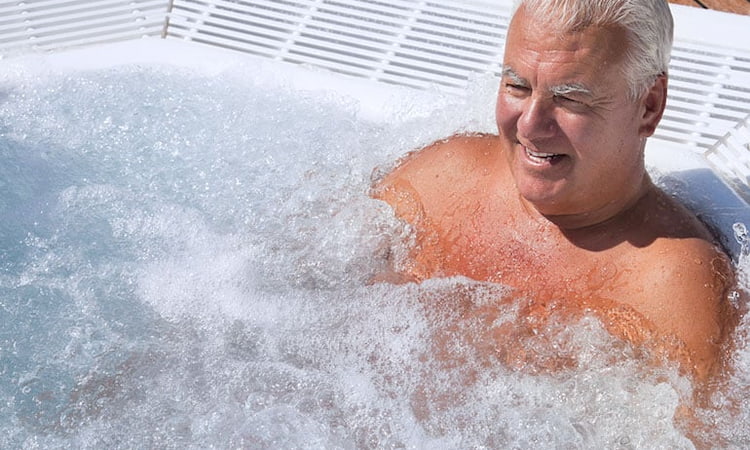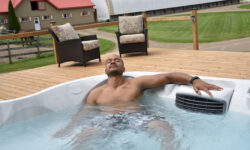You’ve got atrial fibrillation and you’re wondering, “can I safely use a hot tub?” It’s crucial to understand the potential risks and effects heat can have on your heart.
Yes, you can go in a hot tub with atrial fibrillation, but with caution. Sudden changes in temperature can potentially trigger an atrial fibrillation episode, and hot tubs can also cause dehydration, which can increase the risk of blood clots in people with atrial fibrillation. It’s important to consult with your doctor before using a hot tub if you have this condition.
We’ll delve into the research, discuss the possible hazards, and explore safe alternatives for relaxation. Let’s equip you with the knowledge needed to make informed decisions about your health and well-being.

Quick Navigation
Understanding Atrial Fibrillation: The Basics
Before you can fully grasp the implications of hot tub use with atrial fibrillation, you’ll need to understand what atrial fibrillation really is. Atrial fibrillation, often abbreviated as AFib, is the most common type of heart arrhythmia, affecting millions worldwide.
It’s a condition characterized by an irregular and often rapid heart rate, causing poor blood flow throughout the body. In a healthy heart, electrical signals are sent in a regular, orderly pattern from the heart’s upper chambers (the atria) to the lower chambers (the ventricles), resulting in a steady heartbeat.
However, with AFib, these electrical signals become chaotic, causing the atria to fibrillate, or quiver, rather than contract properly. This results in a disorganized, irregular heartbeat that can lead to a range of symptoms, including heart palpitations, shortness of breath, and fatigue.
The Impact of Heat on the Heart
You might not know it, but when you’re lounging in a hot tub, two major changes are happening to your body: your heart rate increases and your blood vessels dilate. This is your body’s reaction to the heat, an attempt to cool you down.
However, for individuals with heart conditions like atrial fibrillation, these changes may present a problem. Here’s why:
- Increased Heart Rate: Soaking in hot water makes your heart work harder. The heat causes your heart rate to quicken, which could potentially trigger irregular heartbeats, especially in those with atrial fibrillation.
- Dilated Blood Vessels: When your blood vessels dilate, they can lower your blood pressure. If it drops too much, you may feel lightheaded or faint.
- Strain on the Heart: The combination of an increased heart rate and lower blood pressure means your heart must work harder to pump blood. This can be risky if you have a heart condition.
Ultimately, while a hot tub can be relaxing, it’s vital to understand the potential risks it poses to your heart, particularly if you have atrial fibrillation. Again, always consult your doctor before using a hot tub.
Risks of Using Hot Tubs for Individuals With Atrial Fibrillation

Often, it’s crucial to remember that using a hot tub can present some unique risks if you’re dealing with atrial fibrillation.
A hot tub’s warm water can cause your heart rate to increase, potentially triggering an atrial fibrillation episode. This is because the heat can cause your blood vessels to expand, which can increase your heart rate and blood flow, potentially overworking your heart.
However, this isn’t the only risk you’ll face. Extended time in a hot tub can lead to dehydration, which can further exacerbate symptoms of atrial fibrillation.
Additionally, sudden changes in temperature, such as moving from a hot tub to a cold pool, can cause physical stress on your body and trigger an episode.
To help you better understand, here’s a breakdown in a table format:
| Risk | Explanation |
|---|---|
| Increased Heart Rate | The heat from the hot tub can increase your heart rate, potentially triggering an atrial fibrillation episode. |
| Dehydration | Extended time in a hot tub can lead to dehydration, which can worsen symptoms. |
| Sudden Temperature Changes | Rapid changes in body temperature can cause physical stress and trigger an episode. |
| Overworking the Heart | Increased heart rate and blood flow from the heat can potentially overwork your heart. |
| Physical Stress | The combination of heat, dehydration, and potential overworking of the heart can put your body under physical stress. |
Therefore, it’s advisable to exercise caution when using a hot tub if you have atrial fibrillation.
Research Findings: Hot Tubs and Atrial Fibrillation
In the midst of your research on atrial fibrillation and hot tub use, you’ll find that studies show mixed results, with some indicating potential risks and others suggesting possible benefits. The key is to understand the nuances of these findings.
First, let’s delve into the potential risks:
- Some studies suggest that hot tubs can increase heart rate, which could potentially exacerbate symptoms of atrial fibrillation.
- There’s evidence that indicates a rise in body temperature, caused by hot tub use, might provoke episodes of atrial fibrillation in some individuals.
- Other research points to the potential for hot tubs to lower blood pressure, a factor that could lead to lightheadedness or fainting in people with atrial fibrillation.
On the flip side, there are also potential benefits. Certain studies indicate that the warmth and relaxation provided by hot tubs could potentially reduce stress levels, which is known to be a trigger for atrial fibrillation.
Safety Measures and Alternatives for Relaxation
While it’s clear that hot tub use might pose potential risks if you have atrial fibrillation, there are safety measures you can take and alternatives for relaxation you can consider. They’re best positioned to give personalized advice based on your medical history.
If you’re given the green light by your doctor, limit your time in the hot tub to 15-20 minutes and avoid extreme temperatures. It’s also important to stay hydrated, as hot tubs can lead to excess sweating. Keep a water bottle nearby and take breaks if you feel lightheaded.
For alternatives, consider lower temperature baths, gentle yoga, or meditation. These options can be just as relaxing and pose less risk.
Another option is a warm (not hot) heating pad applied to tense areas. This can provide localized heat without the full-body stress that a hot tub can cause.
Frequently Asked Questions
Yes, certain medications for atrial fibrillation can interact negatively with hot tub use. Heat can affect your heart rate and blood pressure, potentially countering the medication’s effect. Always consult your doctor first.
You’ll recognize an atrial fibrillation episode in a hot tub by symptoms like rapid, irregular heartbeat, palpitations, fatigue, shortness of breath, dizziness, or faintness. If you experience these, exit the tub and seek medical help.
It’s not about the brand or type of hot tub. It’s more important to monitor your heart rate, avoid extreme temperatures, and limit your time in the tub to reduce potential AFib triggers.
You’re asking about a time limit for hot tub use with atrial fibrillation. It’s vital not to stay too long. Overheating can strain your heart, so limit your soak to 15-20 minutes. Always consult your doctor.
Yes, lifestyle changes and exercises can indeed manage atrial fibrillation risks. Regular exercise, a balanced diet, and limiting alcohol intake improve heart health. Always consult your doctor before starting any new regimen.
Conclusion
In conclusion, if you have atrial fibrillation, using a hot tub may pose risks due to the potential impact of heat on your heart. Research suggests a potential link between hot tub use and triggering atrial fibrillation.
Always prioritize your safety and consider alternatives for relaxation. Consult with your healthcare provider before using a hot tub to ensure it’s safe for you. Your health and well-being should always come first.





![Is Hot Tub Good for Cold? [Potential Risks & Precautions] Is Hot Tub Good for Cold](https://hottubtales.com/wp-content/uploads/2023/10/Is-Hot-Tub-Good-for-Cold.jpg)
